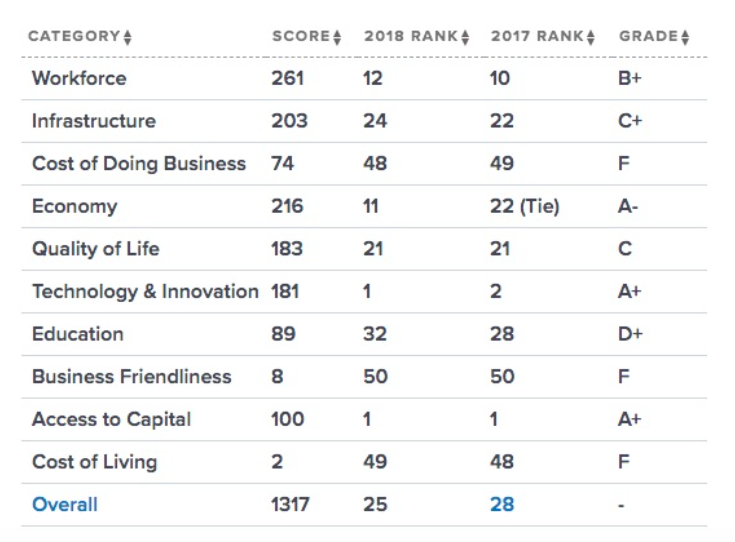Overview
Read on for some statistics and insights about the level of civic engagement, political engagement and a “state of the state” overview of California.
Civic and Political Engagement
According to the Corporation for National and Community Service for 2018:
- 25.4% of residents volunteer, ranking them 47th among the 50 states and Washington, DC.
- 7,883,285 volunteers
- 688.6 million hours of service
- $16.6 billion worth of service contributed
Looking at political engagement specifically, according to this 2018 Wallethub.com study, California ranks #24 based on a weighted average across the following metrics:
- Percentage of Registered Voters in the 2016 Presidential Election
- Percentage of Electorate Who Actually Voted in the 2014 Midterm Elections
- Percentage of Electorate Who Actually Voted in the 2016 Presidential Election
- Change in Percentage of Electorate Who Actually Voted in the 2016 Elections Compared with the 2012 Elections
- Total Political Contributions per Adult Population
- Civic Education Engagement, CIRCLE
- Voter Accessibility Policies, Ballotpedia
Sources: Data used to create this ranking were collected from the U.S. Census Bureau, Center for Responsive Politics, Ballotpedia and Center for Information & Research on Civic Learning and Engagement, CIRCLE.
Women in California Politics:
As of 2018, there are 20 women legislators in the California State Assembly and 9 in the California State Senate for a total of 29 out of 120 seats in both chambers. This equals 24.2% of the legislature (Source: NCSL).
See how many women serve in California’s executive offices here.
California ranks 15th in women’s equality – based on workplace environment (pay, unemployment and entrepreneurship rate disparity), education environment (education levels and math and reading scores), and political empowerment (disparity in elected offices) (Source: Wallethub).
What color is California?
With 55 electoral votes, California currently has the most in the country. According to 270towin, “while growth in the Latino population has helped make California a reliably Democratic state today, this was not always the case. In fact, from 1952 through 1988, Republicans won every presidential election except the landslide loss of Barry Goldwater in 1964. In 2016, Hillary Clinton won the state by 30 points over Donald Trump. This marks the third consecutive election that the Democratic nominee has surpassed 60% in the state.”
State of the State
State Government Structure
The California State Legislature is bicameral, with a lower house, the California State Assembly, and an upper house, the California State Senate.
There are 80 members in the Assembly and 40 in the Senate. Since 2011, California has been a Democratic state government trifecta, meaning that a single political party (in this case the Democratic party) holds the governorship, a majority in the state senate, and a majority in the state house.
Each Assembly member represents an average of 465,674 residents, as of the 2010 Census. Members are limited to three two-year terms. Each Senate member represents an average of 931,349 residents, as of the 2010 Census. Senate members are limited to two four-year terms. California’s Proposition 140, passed in 1990, places a lifetime ban against seeking the same office once the term limits have been reached (Ballotpedia).
Budget Process
The state operates on an annual budget cycle. The sequence of key events in the budget process is as follows:
- Budget instructions are sent to state agencies beginning in April.
- Agencies submit their budget requests to the governor in September.
- Agency hearings are held from September through November.
- Public hearings are held from March through June.
- The governor submits his or her proposed budget to the state legislature in January.
- The legislature adopts a budget in June. A two-thirds majority is required to pass a budget. The fiscal year begins July 1.
California is one of 44 states in which the governor has line item veto authority.
The governor is legally required to submit a balanced budget to the legislature. In turn, the legislature is legally required to adopt a balanced budget. (Ballotpedia)
Business Climate
A CNBC study ranks California #25 in terms of overall business climate:
Freedom
California ranks 48th in Cato Institute’s 2018 Freedom in the 50 states. The overall freedom ranking is a combination of personal and economic freedoms.
Additional Resources
- PEW Fiscal 50: State Trends and Analysis
- PEW Women in Leadership – see analysis of women in leadership on a national scale
- National Association of State Budget Officers (NASBO) Fiscal Survey of States
- Compare 50 – pick what stats you want to compare with what states here
- State Data Lab – compare a variety of factors among states here
- Freedom in the 50 States – Cato
- Tax Foundation facts and figures app is available for download
What You Can Do
As detailed above, Californians have expansive potential for engaging in civic-minded and fiscally responsible activity. By forming Policy Circles across the state, women can lead the way in ensuring that policies are working and responding to individual needs at the local level.
Here’s what you can do:
- Click “It’s easy, start now” at www.thepolicycircle.org to start a circle in your area.
- Read our “Year of Conversation” for an overview of policy briefs on key issues affecting the country and your state.
- Connect with California Policy Center, your state think tank and best resource for state level information on key policy issues.
- Tell a friend or family member about The Policy Circle by sending them to www.thepolicycircle.org. Any woman who believes in the power of free markets to unleash human creativity can start a Policy Circle in her area.
